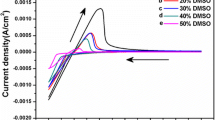Abstract
The charge exchange (CE) characteristics of CdSe nanorod would be manipulated by the TBP and Li+. We employ electrochemical impedance spectroscopy (EIS) and cyclic voltammogram (CV) to scan the CE mechanism of CdSe nanorod. The EIS data shows that TBP would restrict the CE process and the Li+ would show the opposite role. The CV data confirms that the restriction behavior of CE affected by TBP is originated from the filling surface trapping state. Meanwhile, the facilitation of CE process manipulated by Li+ is coming from the creation of new trapping state and the deepening of trapping state. In comparison with TBP, Li+ would exhibit much extensive function in affecting the trapping state. Finally, the results help people to further understand the characteristics of trapping state in the charge property of nanocrystals.




Similar content being viewed by others
References
Bai Y, Zhang J, Zhou DF, Wang YH, Zhang M, Wang P (2011) Engineering organic sensitizers for iodine-free dye-sensitized solar cells: red-shifted current response concomitant with attenuated charge recombination. J Am Chem Soc 133:11442–11445
Bard AJ, Faulkner LR (2001) Electrochemical methods: fundamentals and applications[M], 2nd edn. Wiley, New York
Hagfeldt A, Boschloo G, Sun LC, Kloo L, Pettersson H (2010) Dye-sensitized solar cells. Chem Rev 110:6595–6663
Jian XM, Tu JP, Qiao YQ, Lu Y, Wang XL, Gu CD (2013) Synthesis and electrochemical performance of LiVO3 cathode materials for lithium ion batteries. J Power Sources 236:33–38
Jones M, Kumar S, Lo SS, Scholes GD (2008) Exciton trapping and recombination in type II CdSe/CdTe nanorod heterostructures. J Phys Chem C 112:5423–5431
Law M, Greene LE, Johnson JC, Saykally R, Yang PD (2005) Nanowire dye-sensitized solar cells. Nat Mater 4:455–459
Li JT, Cushing SK, Zheng P, Tess S, Meng FK, Bristow AD, Manivannan A, Wu NQ (2014) Solar hydrogen generation by a CdS-Au-TiO2 sandwich nanorod array enhanced with au nanoparticle as electron relay and plasmonic photosensitizer. J Am Chem Soc 136:8438–8449
Nan W, Niu Y, Qin H, Cui F, Yang Y, Lai R, Lin W, Peng X (2012) Crystal structure control of zinc-blende CdSe/CdS core/shell nanocrystals: synthesis and structure-dependent optical properties. J Am Chem Soc 134:19685–19693
Orazem ME, Tribollet B (2008) Electrochemical impedance spectroscopy[M], 1st edn. Wiley, New York
Peng ZA, Peng XG (2002) Nearly monodisperse and shape-controlled CdSe. J Am Chem Soc 124:3343–3353
Rui XH, Jin Y, Feng XY, Zhang LC, Chen CH (2011) A comparative study on the low-temperature performance of LiFePO4/C and Li3V2(PO4)3/C cathodes for lithium-ion batteries. J Power Sources 196:2109–2114
Sauvage F, Decoppet JD, Zhang M, Zakeeruddin SM, Comte P, Nazeeruddin M, Wang P, Grätzel M (2011) Effect of sensitizer adsorption temperature on the performance of dye-sensitized solar cells. J Am Chem Soc 113:9304–9310
Tachibana Y, Akiyama HY, Ohtsuka Y, Torimoto T, Kuwabata S (2007) CdS quantum dots sensitized TiO2 sandwich type photoelectrochemical solar cells. Chem Lett 36:88–89
Tachibana Y, Umekita K, Otsuka Y, Kuwabata S (2008) FAST TRACK COMMUNICATION: Performance improvement of CdS quantum dots sensitized TiO2 solar cells by introducing a dense TiO2 blocking layer. J Phys D Appl Phys 41:1–5
Veamatahau A, Jiang B, Seifert T, Makuta S, Latham K, Kanehara M, Teranishid T, Tachibana Y (2015) Origin of surface trap states in CdS quantum dots: relationship between size dependent photoluminescence and sulfur vacancy trap states. Phys Chem Chem Phys 17:2850–2858
Wang P, Zhang J, He HL, Xu XL, Jin YD (2015) The important role of surface ligand on CdSe/CdS core/shell nanocrystals in affecting the efficiency of H2 photogeneration from water. Nanoscale 7:5767–5775
Yu QJ, Wang YH, Yi ZH, Zu NN, Zhang J, Zhang M, Wang P (2010) High-efficiency dye-sensitized solar cells: the influence of lithium ions on exciton dissociation, charge recombination, and surface states. ACS Nano 4:6032–6038
Zeng Q, Kong X, Sun Y, Zhang Y, Tu L, Zhao J, Zhang H (2008) Synthesis and optical properties of type II CdTe/CdS core/shell quantum dots in aqueous solution via successive ion layer adsorption and reaction. J Phys Chem C 112:8587–8593
Zheng J, Yuan X, Ikezawa M, Jing P, Liu X, Zheng Z, Kong X, Zhao J, Masumoto Y (2009) Efficient photoluminescence of Mn2+ ions in MnS/ZnS core/shell quantum dots. J Phys Chem C 113:16969–16974
Funding
This work was supported by the National Natural Science Foundation of China (Nos. 21573094, 51502109, 11774122, 11574112, and 11474131) and the National Found for Fostering Talents of Basic Science (No. J1103202), and the support provided by China Scholarship Council (CSC) during a visit of Ning Sui (No. 201706175038) to MPIA is acknowledged.
Author information
Authors and Affiliations
Corresponding authors
Ethics declarations
Conflict of interest
The authors declare that they have no conflict of interest.
Additional information
Publisher’s note
Springer Nature remains neutral with regard to jurisdictional claims in published maps and institutional affiliations.
Rights and permissions
About this article
Cite this article
Lou, X., Sui, N., Zhang, Lq. et al. Role of surface trapping state in the charge exchange characteristics of CdSe nanorod. J Nanopart Res 21, 92 (2019). https://doi.org/10.1007/s11051-019-4529-y
Received:
Accepted:
Published:
DOI: https://doi.org/10.1007/s11051-019-4529-y




